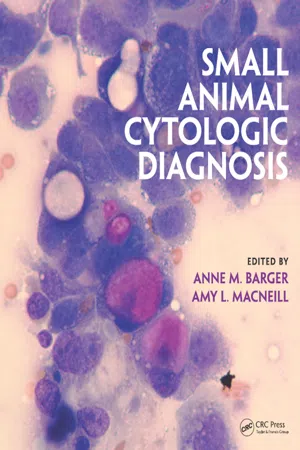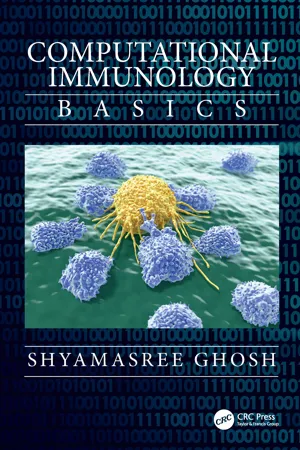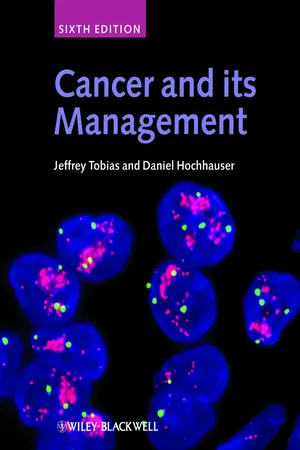Cancer
Cancer is a disease characterized by the uncontrolled growth and spread of abnormal cells in the body. These cells can form tumors and interfere with normal bodily functions. Cancer can arise from various factors, including genetic mutations, environmental exposures, and lifestyle choices, and it can affect any part of the body. Treatment options for cancer include surgery, chemotherapy, radiation therapy, and targeted therapies.
7 Key excerpts on "Cancer"
- eBook - ePub
- Anne M. Barger, Amy MacNeill, Anne M. Barger, Amy MacNeill(Authors)
- 2016(Publication Date)
- CRC Press(Publisher)
...CHAPTER 3 Cancer BIOLOGY Timothy M. Fan INTRODUCTION Cancer biology is an immense scientific discipline that incorporates complementary knowledge derived from diverse exploratory studies pertaining to cellular malignant transformation. Despite its universality in complex, multicellular organisms, various descriptive terms are used to describe unregulated cell growth including neoplasia, tumor, malignancy, and Cancer. By definition these descriptive terms are not equivalent; however, they are often used interchangeably. Based on biologic behavior, tumors can be categorized as being benign or malignant. Benign tumors are transformed cell populations that grow locally and do not disseminate beyond the site of origination. Conversely, malignant tumors are invasive and have the capacity to spread regionally and distantly through lymphatic or hematogenous routes. Being a common cause of mortality in human beings and companion animals, Cancer and a deeper understanding of its biology has become a societal priority. In the USA and other developed countries worldwide, Cancer remains the second leading cause of death, only exceeded by heart disease, with 1 out of 4 people dying as a result of uncontrolled Cancer progression. Similarly, the most common pathophysiologic process causing deaths in adult dogs (>1 year old) is the development of Cancer (Fleming et al., 2011), with 1 out of 3 adult dogs dying from this single pathologic condition. Based on the substantive fraction of human beings and companion animals that suffer and subsequently succumb to Cancer, a strong and clinically warranted impetus exists for studying tumor biology. With focused initiatives that incorporate scientists and clinicians from diverse professional disciplines, it is anticipated that new knowledge will be generated that better elucidates the molecular underpinnings of Cancer...
- eBook - ePub
- Nessar Ahmed, Maureen Dawson, Chris Smith, Ed Wood(Authors)
- 2007(Publication Date)
- Taylor & Francis(Publisher)
...Cancer cells fail to respond to the usual controling signals and their growth becomes unregulated. Indeed, the name Cancer comes from a Latin word meaning ‘a crab’, and describes the manner in which the pattern of penetration into normal tissues by the abnormal growth bears a superficial resemblance to a crab’s claw. These abnormal cells may invade nearby tissues and may enter the blood and lymph systems and spread to remoter areas. Figure 17.1 Some intrinsic and extrinsic factors that influence cell division. Today, the term Cancer is used popularly to describe what is known as a malignant tumor. Oncology, derived from the Greek word oncos, a lump, is the branch of medicine involved with the study of the development of tumors, their epidemiology, diagnosis and treatment. A tumor is an abnormal mass of cells that may be benign or malignant. Benign tumors generally grow slowly and do not spread to other tissues, though they may continue to grow in situ. Such tumors are only harmful if they interfere with the normal function of a tissue, or if they cause pressure by growing within a confined space, such as in the brain. A malignant tumor is one that spreads from its initial site, where it is known as the primary tumor, through the blood and lymph to establish secondary tumors in other organs. Such movement from the primary tumor and the formation of secondary tumors is known as metastasis. A term that is often used in the context of Cancer is neoplasm. This means, literally, a new tumor or new mass, but is generally used to describe a Cancer. The causes of Cancer are complex and varied. Some arise from environmental agents called carcinogens, others are brought about by oncogenic, that is Cancer-inducing, viruses. Most Cancers arise, ultimately, from mutations in DNA...
- eBook - ePub
- John E. Niederhuber, James O. Armitage, James H Doroshow, Michael B. Kastan, Joel E. Tepper(Authors)
- 2019(Publication Date)
- Elsevier(Publisher)
...Molecular biology provides the basic tools to study genes involved with Cancer growth patterns and tumor suppression. An advanced understanding of the molecular processes governing cell growth and differentiation has revolutionized the diagnosis, prognosis, and treatment of malignant disorders. • This introductory chapter relates basic principles of molecular biology to emerging perspectives on the origin and progression of Cancer and explains newly developed laboratory techniques, including whole-genome analysis, expression profiling, and refined genetic manipulation in and use of genetically diverse animal models, providing the conceptual and technical background necessary to grasp the central principles and new methods of current Cancer research. Since the last edition of this book was published, advances in our understanding of the basic mechanisms of Cancer have continued to inform and refine clinical approaches to prevention and therapy. New prognostic and predictive markers derived from molecular biology can now pinpoint specific genetic changes in particular tumors or detect occult malignant cells in normal tissues, leading to improved technologies for tumor screening and early detection. Diagnostic approaches have expanded from morphologic criteria and single-gene analysis to whole-genome technologies and single-cell genomics imported from other biologic disciplines. A new systemic vision of Cancer is emerging, in which the importance of individual mutation has been superseded by an appreciation for higher-order organization and individual genetic background, disrupted by complex interactions of disease-associated factors and gene-environmental parameters that affect tumor cell behavior...
- eBook - ePub
Recent Advances in Cancer Diagnostics and Therapy
A Nanobased Approach
- Anjana Pandey, Saumya Srivastava(Authors)
- 2022(Publication Date)
- CRC Press(Publisher)
...In this chapter, characteristic features of Cancer, its staging, types, causes, Cancer etiology and molecular perspectiveare discussed. 1.2 Features of Cancer In our bodies, the regulatory system is present to control cell proliferation and homeostasis. Cancer cells have a defect that enables them to violate the normal process. Six essential alterations are there that collectively define Cancer cell genotype and are responsible for malignant growth, self-sufficiency in growth signals, insensitivity to antigrowth signals, programmed cell death evasion, unlimited replicative skills, prolonged angiogenesis, and metastasis (Figure 1.1) (Hanahan and Weinberg, 2000 ; Fouad and Aanei, 2017). Figure 1.1 Cancer characteristics. 1.2.1 Self-Sufficient Signals for Growth Mitogenic growth signals that are required for normal cell growth are transmitted into the cell by transmembrane receptors that bind with different classes of signaling molecules, extracellular matrix components, transmissible growth factors, and cell-to-cell interaction adhesion molecules (Witsch et al., 2010 ; Di Domenico and Giordano, 2017). Different oncogenes related to Cancer act by mimicking the normal growth signaling patterns (Argyle and Khanna, 2013). Normal cell propagation depends on growth signaling in culture. Their proliferation requires appropriate transmissible mitogenic factors and a proper base for their integrins. In contrast to this, Cancer cells do not show dependence on exogenous growth signaling; they generate the growth signals on their own, which disrupts the homeostatic environment of a cell within the tissue. This character of tumor cells is acquired GS (growth signal) autonomy, which plays a very important role in the Cancer cell to modulate dominant oncogenes...
- eBook - ePub
Computational Immunology
Basics
- Shyamasree Ghosh(Author)
- 2019(Publication Date)
- CRC Press(Publisher)
...10 Cancer Biology 10.1 INTRODUCTION The daughter cells of a dividing parent cell that has lost the controlled cell division form a tumour and when they migrate and grow in the other tissues, it is called Cancer. Malignant tumours differ from the benign tumours by their growth and evasiveness. Metastatic Cancer cells secrete matrix metalloproteinases that degrades the extracellular matrix proteins. The malignant cells then migrate by chemotaxis through the blood vessels into different sites of the body giving rise to the secondary tumour. Growth of metastatic Cancer is stimulated by adequate blood supply for nutrients and oxygenation and removal of cellular waste through angiogenesis [ 1, 2 ]. The hypoxic environment of Cancers induces expression of hypoxia-inducible factor-1alpha (HIF-1 α) which regulates angiogenic growth factors like vascular endothelial growth factor (VEGF) [ 1, 2, 3 ]. Cytokines, interleukins, and other growth factors contribute to angiogenesis for Cancer proliferation [ 1, 2, 3 ]. In 2000, Hanahan and Weinberg listed six significant alterations essential for malignant growth (a) self-sufficient growth signals, (b) insensitivity to antigrowth signals, (c) replicative potential, (d) ability to evade apoptosis, sustained angiogenesis, (e) ability to invade the tissues, and (f) metastasis Recent studies have revealed that exploitation of immune mechanisms and evasion of immune surveillance are hallmarks in Cancer cell development [ 138 ]. Tumours are classified based on the tissue of their origin. Carcinomas develop from endodermal or ectodermal tissues like skin, glands, as in breast Cancer, colon Cancer, and lung Cancer. The Cancers originating in the mesodermal tissue of bone, blood vessels and cartilage are called the sarcomas. Malignant hematopoietic cells give rise to leukemia that originate from myeloid and lymphoid lineages...
- eBook - ePub
Cancer
Basic Science and Clinical Aspects
- Craig A. Almeida, Sheila A. Barry(Authors)
- 2011(Publication Date)
- Wiley-Blackwell(Publisher)
...5 Tumor formation, growth, and metastasis Growth for the sake of growth is the ideology of the Cancer cell. Edward Abbey, American Writer CHAPTER CONTENTS Tissue changes that occur in response to stimuli Feeding tumor growth by angiogenesis Characteristics of benign and malignant tumors Events that occur during the process of metastasis Expand your knowledge Additional readings Chapter 4 discussed the regulation of the cell cycle that is critical in maintaining the structural and functional integrity of all tissues. The inability to control passage of a cell through each of the cycle checkpoints can result in unwanted growth within a tissue. The growth not only can disrupt the function of that tissue but also of those nearby. The situation becomes much more serious if cells break free from the tumor and travel to other tissues where they may take up residence, multiply, and create additional problems. This chapter will examine the events that are involved in transforming normal cells into Cancerous ones, allowing for the formation of tumors and the spreading of Cancer cells from their original growth site to other locations in the body. TISSUE CHANGES THAT OCCUR IN RESPONSE TO STIMULI Our cells experience many different types of chemical and physical stimuli on an almost constant basis. For example, our cells are exposed to both beneficial and harmful chemicals in the air, food, and water we take into our bodies, hormones surging through our bloodstreams relaying messages to the cells to which they bind, and stresses and strains are applied when we move heavy objects. The type and strength of the stimuli cells receive or are subjected to affect the structural and functional changes they will undergo. The cellular changes that occur in response to stimuli are an indication of both the susceptibility to signals and the adaptability that cells exhibit in response to changes in their environment...
- eBook - ePub
- Jeffrey S. Tobias, Daniel Hochhauser(Authors)
- 2013(Publication Date)
- Wiley-Blackwell(Publisher)
...The restriction point in the cell cycle marks the point at which cells are irreversibly committed to proceeding with DNA replication. This depends on the presence of exogenous nutrients and growth factors in normal cycling cells. An important property of Cancer cells is their ability to continue the cell cycle in the presence of nutrient deprivation. Additionally, Cancers always show a degree of anaplasia, which is a failure of the mechanism of cellular differentiation. Critically, Cancers have the ability to metastasize, that is the ability to spread from the site of origin to distant tissues. While these features are present in most human Cancers, some of these properties are not absolutely distinct from normal tissues. Thus it is true that the normal regulatory mechanisms controlling growth are defective in Cancer, but there often remains a check or constraint on the pattern of growth of human neoplasms (see below). Similarly, although we regard the most anaplastic of Cancers as ‘undifferentiated’ in the sense that they seem to have arisen from the more primitive precursors of the differentiated tissue, many Cancers nonetheless do retain some of the functions of the mature tissues. Metastasis, however, is a property unique to Cancer. Furthermore, it is metastasis which in most instances kills the patient, and understanding the biology of metastasis is one of the central problems of Cancer research. The following section is concerned with the events that follow the carcinogenic event and which lead to the development of an invasive, metastasizing malignancy. Monoclonality and heterogeneity in Cancer It is probable that most human neoplasms are monoclonal in origin. This means that the original oncogenic events affected a single cell and that the tumour is the result of growth from that one cell. There are two major lines of evidence which have led to this conclusion...






